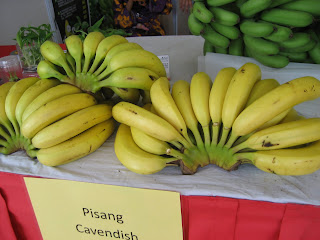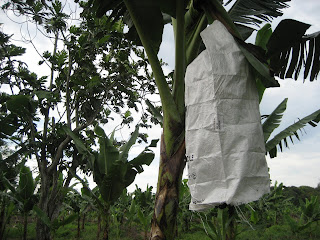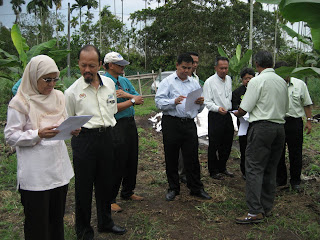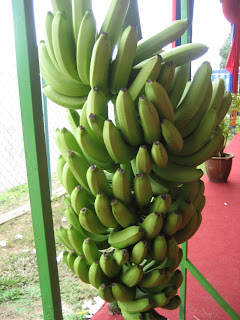.jpg) Banana (Musa spp) or Pisang in Malays are tropical fruit under family Musaceae. Banana has special demand in tropical and subtropical country as source of fresh and considered healthy food and a lot of energy. Professional Sportsman eat banana before start playing for energy such as Andre Agasi (Tennis Player), Micheal Schumacher (F1 Racing Team) and Martina Navratilova (Tennis). Banana was popular among small farmers and estates (in Philippines) . Top banana producers in Asia were Philippines, Thailand, Indonesia, India and Malaysia. Other countries producing banana was South America continents, Australia continents and others. Only two type of banana edible to humans that is Musa accuminata and Musa balbisiana Colla. This article explain my experience on banana growing activity as an extension agent. This article in "Anim Agro Technology" I would like to share about banana industry in Malaysia based on my observation and intellectual research.
Banana (Musa spp) or Pisang in Malays are tropical fruit under family Musaceae. Banana has special demand in tropical and subtropical country as source of fresh and considered healthy food and a lot of energy. Professional Sportsman eat banana before start playing for energy such as Andre Agasi (Tennis Player), Micheal Schumacher (F1 Racing Team) and Martina Navratilova (Tennis). Banana was popular among small farmers and estates (in Philippines) . Top banana producers in Asia were Philippines, Thailand, Indonesia, India and Malaysia. Other countries producing banana was South America continents, Australia continents and others. Only two type of banana edible to humans that is Musa accuminata and Musa balbisiana Colla. This article explain my experience on banana growing activity as an extension agent. This article in "Anim Agro Technology" I would like to share about banana industry in Malaysia based on my observation and intellectual research..jpg) In Malaysia among few cultivars popular grown were Berangan, Mas and Cavendish for domestic consumption and export market. The other three cultivars grown locally and only for domestic was Pisang Raja, Pisang Rastali and Pisang Nangka. There report by DOA shows that about 26,885 hectare (ha) of banana was grown in 2006 (producing about 258,482 metric ton) and increase to 28,640 ha in 2009 (Production - 283,220 mt). Johor is the largest banana producers in the country with Batu Pahat District (1,670 ha) has the largest banana area followed by Pontian District (1,663 ha) and Muar District (1,532 ha) respectively. Other states was Perak, Selangor, Pahang, Negri Sembilan and Sabah.
In Malaysia among few cultivars popular grown were Berangan, Mas and Cavendish for domestic consumption and export market. The other three cultivars grown locally and only for domestic was Pisang Raja, Pisang Rastali and Pisang Nangka. There report by DOA shows that about 26,885 hectare (ha) of banana was grown in 2006 (producing about 258,482 metric ton) and increase to 28,640 ha in 2009 (Production - 283,220 mt). Johor is the largest banana producers in the country with Batu Pahat District (1,670 ha) has the largest banana area followed by Pontian District (1,663 ha) and Muar District (1,532 ha) respectively. Other states was Perak, Selangor, Pahang, Negri Sembilan and Sabah..jpg) Pisang Berangan maturity period was 12 month after planting and with planting distance of 3m x 3m giving 1,100 trees/ha whereby the potential yield about 52 mt/ha. Pisang Berangan mostly consumed as Fresh Fruit and for processing downstream. Pisang Mas maturity period was shorter about 8 months and with planting distance 2.5 m x2.5 m giving 1,600 trees/ha in which the potential yield about 43 mt/ha. Pisang Mas also used as fresh fruit. Pisang Rastali maturity period was 12 months and was planted with 3m x 3m distance giving 1,100 tree/ha at potential yield of 45 mt/ha. Pisang Cavendish need 13 months to mature and planted at 3mx3m distance with 97 mt/ha as potential yield. Other cultivars but not so popular grown were Pisang Nangka, Pisang Awak, Pisang Masak Hijau, Pisang Embun and Pisang Monyet etc.
Pisang Berangan maturity period was 12 month after planting and with planting distance of 3m x 3m giving 1,100 trees/ha whereby the potential yield about 52 mt/ha. Pisang Berangan mostly consumed as Fresh Fruit and for processing downstream. Pisang Mas maturity period was shorter about 8 months and with planting distance 2.5 m x2.5 m giving 1,600 trees/ha in which the potential yield about 43 mt/ha. Pisang Mas also used as fresh fruit. Pisang Rastali maturity period was 12 months and was planted with 3m x 3m distance giving 1,100 tree/ha at potential yield of 45 mt/ha. Pisang Cavendish need 13 months to mature and planted at 3mx3m distance with 97 mt/ha as potential yield. Other cultivars but not so popular grown were Pisang Nangka, Pisang Awak, Pisang Masak Hijau, Pisang Embun and Pisang Monyet etc..jpg) Banana required fertile soil with proper drainage system and lots of organic manure. Soil humidity also important for banana to grow and produce high quality banana. Banana roots required high oxygen content and good soil condition such as Local River alluvium soil. Rainfall between 1,000 - 2,000 mm/year is the most suitable with no drought through out the year. Land preparation started with land clearing, stacking, ploughing, construction of farm roads and drainage system. Liming is important to increase soil pH and fertility at 2 mt/ha. Water requirement for banana plantation is important from beginning and drip irrigation system. Planting hole of 30 cm x 30 cm x 30cm must prepared and apply 100 gm/hole of CIRP, 60 gm/hole of NPK 8:8:8 and 60 gm/hole of GML. Source of seedling from selected traditional suckers (sulur) or Tissue Culture or by Quartering Techniques. Suckers requirement range from 1,100 - 1,600 /ha depend on planting distance, soil type, planting layout and cultivars. Apply carbofuran for suckers treatments to reduce mortality. Watering for newly planted banana suckers is a must at least for one week. Water requirements for banana about 8-12 liters /tree. Apply NPK 15:1515 about 100 gm/tree from 1st month to 2 years old. Application of fertilizers by pocket system or 5-30 cm under canopy. Amount of fertilizer refer to Package Technology by DOA and advice by Extension Agent from DOA's.
Banana required fertile soil with proper drainage system and lots of organic manure. Soil humidity also important for banana to grow and produce high quality banana. Banana roots required high oxygen content and good soil condition such as Local River alluvium soil. Rainfall between 1,000 - 2,000 mm/year is the most suitable with no drought through out the year. Land preparation started with land clearing, stacking, ploughing, construction of farm roads and drainage system. Liming is important to increase soil pH and fertility at 2 mt/ha. Water requirement for banana plantation is important from beginning and drip irrigation system. Planting hole of 30 cm x 30 cm x 30cm must prepared and apply 100 gm/hole of CIRP, 60 gm/hole of NPK 8:8:8 and 60 gm/hole of GML. Source of seedling from selected traditional suckers (sulur) or Tissue Culture or by Quartering Techniques. Suckers requirement range from 1,100 - 1,600 /ha depend on planting distance, soil type, planting layout and cultivars. Apply carbofuran for suckers treatments to reduce mortality. Watering for newly planted banana suckers is a must at least for one week. Water requirements for banana about 8-12 liters /tree. Apply NPK 15:1515 about 100 gm/tree from 1st month to 2 years old. Application of fertilizers by pocket system or 5-30 cm under canopy. Amount of fertilizer refer to Package Technology by DOA and advice by Extension Agent from DOA's..jpg) Weed control by done manual or chemical spraying (Glufosinate ammonium at 132 ml/ha with 18 liter water). Apply NPK 15:15:15 at 100-150 gm/tree when the banana at vegetative period. Manuring with NPK 12:12:17:2 about 75 gm/tree applied 6 months after planting. Thinning of new sucker done to maintain reasonable numbers ( 3 tree/point) . Ratoon the suckers gradually with first suckers and second suckers with appropriate arrangement. Wrap the banana bunch with special newspapers and plastic (size 75 cm x 120 cm at the latest stage of fruit formation. Matured banana harvested 12-13 months after planting with special techniques so that the banana bunch maintain the quality and not damage due to soft landing on the ground.
Weed control by done manual or chemical spraying (Glufosinate ammonium at 132 ml/ha with 18 liter water). Apply NPK 15:15:15 at 100-150 gm/tree when the banana at vegetative period. Manuring with NPK 12:12:17:2 about 75 gm/tree applied 6 months after planting. Thinning of new sucker done to maintain reasonable numbers ( 3 tree/point) . Ratoon the suckers gradually with first suckers and second suckers with appropriate arrangement. Wrap the banana bunch with special newspapers and plastic (size 75 cm x 120 cm at the latest stage of fruit formation. Matured banana harvested 12-13 months after planting with special techniques so that the banana bunch maintain the quality and not damage due to soft landing on the ground. Banana may attacked with few pest such as Stem Borer (Cosmopoites sordidus) which the larvae able damage the base and cause the tree to fall on severe attack. Control with healthy planting material or use chemicals (Carbofuran) and use proper pest-trap for adult beetle. Other pest was Trunk Borer (Odaiorus longicollis) with similar symptom and control measures as before. Leaf Rolled Pest (Erionata thrax) cause damage to leaf by cutting and rolled the leaf then later rot. Collect and burn affected leaves. Other pests was Trips that able reduce fruit quality and controlled by chemicals. Fruit Fly (Bactocera spp) also attack banana but not very serious. Nematod (Radpholus simillis) attack banana in root system and if not properly controll able to cause other secondary disease that is Fungi (Rhizoctonia solani) and Fusaruim oxyporium. Other disease was Sigatoka Disease and Panama Wilt. Application of chemical and IPM able to reduce this problem.
Banana may attacked with few pest such as Stem Borer (Cosmopoites sordidus) which the larvae able damage the base and cause the tree to fall on severe attack. Control with healthy planting material or use chemicals (Carbofuran) and use proper pest-trap for adult beetle. Other pest was Trunk Borer (Odaiorus longicollis) with similar symptom and control measures as before. Leaf Rolled Pest (Erionata thrax) cause damage to leaf by cutting and rolled the leaf then later rot. Collect and burn affected leaves. Other pests was Trips that able reduce fruit quality and controlled by chemicals. Fruit Fly (Bactocera spp) also attack banana but not very serious. Nematod (Radpholus simillis) attack banana in root system and if not properly controll able to cause other secondary disease that is Fungi (Rhizoctonia solani) and Fusaruim oxyporium. Other disease was Sigatoka Disease and Panama Wilt. Application of chemical and IPM able to reduce this problem.
Growing banana is a profitable activity for farmers. Most small farmers grow banana as mixed crop with oil palm, rubber or mixed orchard as an inter crop. Banana used as an inter crop in the Replanting Program by RISDA or by private sector. Growing banana need RM 3,450/ha as capital and normally the ex-farm in Muar banana priced between RM 0.80 - RM 1.20 depend on cultivar and quality.
EAT BANANA...PLANT BANANA...
A DISEASE... CALLED PANAMA...
MANY CULTIVARS.... BERANGAN...
GROW BANANA... BEST INCOME...
Related artilles :
1. Klon Buah Popular di Malaysia (Klik disini)
2. Balut Tandan Pisang (Klik disini)
3. Amalan Pertanian Baik (Klik disini)
4. Proses Jantung Pisang (Klik disini)
By
M Anem
Senior Agronomsit,
Berangan Commersial Fruit Farms,
Batu 18, Pagoh,
Muar, Johor,
Malaysia
(12 Mac 2010)
EAT BANANA...PLANT BANANA...
A DISEASE... CALLED PANAMA...
MANY CULTIVARS.... BERANGAN...
GROW BANANA... BEST INCOME...
Related artilles :
1. Klon Buah Popular di Malaysia (Klik disini)
2. Balut Tandan Pisang (Klik disini)
3. Amalan Pertanian Baik (Klik disini)
4. Proses Jantung Pisang (Klik disini)
By
M Anem
Senior Agronomsit,
Berangan Commersial Fruit Farms,
Batu 18, Pagoh,
Muar, Johor,
Malaysia
(12 Mac 2010)

No comments:
Post a Comment
Note: Only a member of this blog may post a comment.